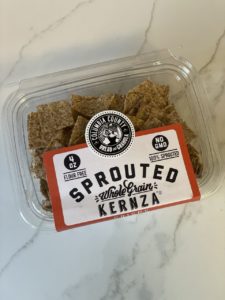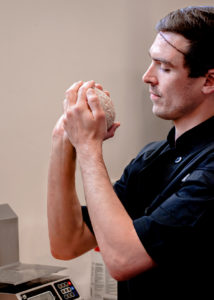Interview with Columbia County Bread and Granola
An Interview with Doug Michael, Owner of Columbia County Bread and Granola
This interview is part of a series which highlights the work of various individuals and organizations within the Kernza® network. Through these interviews, we aim to share and celebrate that there is a large and ever-changing ecosystem that moves Kernza® perennial grain forward. If you would like your organization’s work to be featured in an interview, please email Sophia Skelly. To learn more about the Kernza® network, visit our directory.
How did you first hear about Kernza?
I honestly don’t remember. I just know that it was something that caught my eye and when I looked into it, I immediately thought it was something that we wanted to support. I think I was reading about a baker in the Chicago or San Francisco area that was testing Kernza®. My immediate thought when I see something like that is oh, I wonder if it will sprout well and if we can utilize it as a sprouted product. So, I was able to get a hold of some and we liked it a lot. We have not been able to utilize 100% Kernza in bread or crackers because it lacks a certain extensibility. But it mixes really well with the organic sprouted wheat that we use. We can pretty much go from there and make whatever we want to. With approximately 25% Kernza, we can do bread, we can do pizza crust and we can do crackers. We’ve found that a lot of people are really just interested in the flour. We’ve had a lot of requests for sprouted Kernza® flour. That’s becoming almost more popular on our end than the Kernza crackers for whatever reason. We haven’t really been promoting the flour but people are finding us.
How does Kernza® fit in with your business and mission?
We’re certainly aware of the problems with industrial agriculture and it’s devastation in so many ways – not just personal health but to the planet and the agricultural waste flow that goes down the Mississippi and into the delta and the kill zone. All that stuff is really disturbing. So we do try to source organic and locally. In fact, the only grain that we’re buying right now that isn’t out of Pennsylvania is Kernza®. And we’d love to get it sourced locally. I’ve been talking to different growers about how they should be looking into it. So far we haven’t found anyone but I hope that will change soon. I hope that eventually there will be growers here on the east coast that take a crack at it.
We want to do our part to source high quality grain. Basically, we just advocate for sprouted. We think if you’re going to eat grain, it really has to be prepared for digestion and the simplest, easiest way to do that is just to soak it and sprout it and that’s true of any grain we use. And even the flax we use for granola, we soak it. With the grain, we can look at it and see that it’s sprouting. It’s really no longer a grain at that point; it’s becoming a vegetable, it’s becoming wheatgrass. So that’s kind of our philosophy. It’s what we advocate for.
How did you acquire grain during the early years?
When I found out about Kernza®, I thought, wow, I’d love to work with this. I reached out to The Land Institute and heard back from them saying they would be in touch. Probably a year went by. I would check in periodically and just said, “hey, we’re still interested.” And finally they were able to send us some. At that point, it was through Plovgh. The first batch we got was….it was not clean at all. One of the reasons we like to sprout grain is because we soak it and if there’s any extraneous organic material, it generally rises to the surface and we can skim it out. There’s always cloudy and dirty water so when we soak, we tend to do about three or four rinses so that the water runs clear before we start working with it. With Kernza, it was about 10-15% just different matter. So I got in touch with them and said you know, we’re having a little bit of an issue with that and they acknowledged that it wasn’t as clean as they wanted it. And then, we couldn’t get any more but we eventually did hear back from Tessa and Christopher Abbott with Sprowt Labs and they were able to get us more Kernza®. And this new batch of Kernza is very clean. It’s really nice so they’ve obviously addressed that issue. We still soak and rinse a few times but it’s probably 99.9% Kernza®. There’s very little organic matter that isn’t grain.
Who do you collaborate with primarily within the Kernza® network?

We source from Sprowt Labs and they do a great job so unless we can get it locally, I’m more than happy to work with them. There’s a research study going on out of Bowling Green University and they’re interested in marketing features for how to market Kernza®. So, we’re waiting to hear back from him because we would love to help him out. I do get requests from students. I got a request the other day from some students who are involved in a competition and they wanted some Kernza® so we supplied that for them and just asked them to pay for shipping. I hear they did well. I’m happy to do that. We have had requests in the past from different groups that find out about Kernza® and they just want to play with it or feature it in something. We’re happy to get the word out and if they’re interested in sprouted Kernza®, we can provide that. I was talking to Christopher Abbott about the fact that we’re getting so many requests for sprouted Kernza® flour and we’d be happy to offer the sprouted Kernza® flour to their customers. Because I think they’re going to do really well.
How do your customers react to Kernza®?
When we ship out, we include some information about Kernza® so that when people get their orders, they can look at it and think “Wow, maybe I’ll try this because of the benefits and advantages to this product and I want to support it.” That’s really, initially, the case.
As far as the response, it’s been pretty good. A lot of people just aren’t aware of it. When we go out to the local markets, we always bring Kernza® and most people have no idea what it is or why we’re interested in it. So getting the word out, it still feels like we’re in the early stages of awareness and I hope that changes because I think once people do find out about it, they’ll want to try and incorporate it as much as possible. And I’m curious to know what The Land Institute has next….

How do you think you contribute to moving Kernza® perennial grain forward?
Well, I’d like to see demand increase to the point where we’re offering an entire line of Kernza® products. Right now, we just offer a Kernza® cracker but ideally I wouldn’t mind incorporating Kernza® into all our crackers. You know, cost is a little bit of a feature on that. We can manage to some extent but if I know that the interest and demand is there, then that’s probably the move we’d like to make: feature Kernza® in all our products. And that would include bread, pizza crust, and possibly pita. Those are kind of our premiere lines, because we do a sprouted sourdough base with a sprouted grain mash and we’re only adding a little bit of salt to that so it’s a unique product. I hear all the time from people that they simply can’t eat bread anymore and then they found our stuff and they feel like they can eat bread again. So, whatever we’re doing is mitigating the effects…and I think in my mind, it’s not even really about gluten. It’s more about the industrial food supply that is so poisonous and toxic. And, once you step outside of that, you’re just not going to have the same reaction to bread and crackers, etc. So we’re happy to be offering something that people find they can eat and we feel that Kernza® fits right into that philosophy.
Is there anything I haven’t asked that you would like to share?
Well, I don’t do a lot of milling here so I just have a little home mill that I use but man, Kernza® flour comes out and it’s golden, it smells really good, it’s just a beautiful flour. In comparison to anything else that we’ve looked at, it’s really gorgeous and it smells great. So I’m hoping a lot of home bakers are able to find it and try to incorporate it.